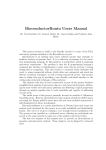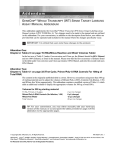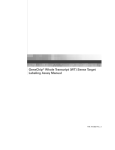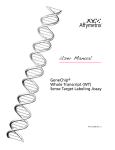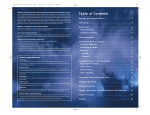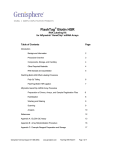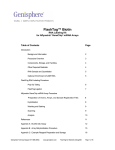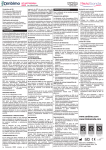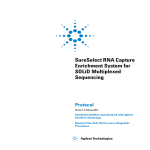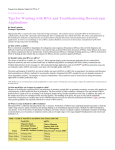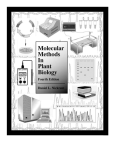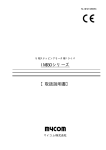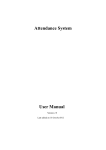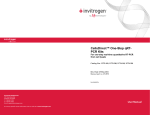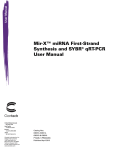Download RiboMinus RNA - Thermo Fisher Scientific
Transcript
RiboMinus™ Transcriptome Isolation Kit For efficient isolation of RiboMinus™ RNA Catalog no. K1550-01 Version B 3 January 2005 25-0966 Corporate Headquarters Invitrogen Corporation 1600 Faraday Avenue Carlsbad, CA 92008 T: 1 760 603 7200 F: 1 760 602 6500 E: [email protected] For country-specific contact information visit our web site at www.invitrogen.com User Manual ii Table of Contents Table of Contents ..........................................................................iii Experienced Users Procedure...................................................... iv Kit Contents and Storage.............................................................. vi Accessory Products .....................................................................viii Overview........................................................................................ 1 Product Specifications ................................................................... 4 Experimental Overview.................................................................. 5 Preparing Total RNA...................................................................... 6 Selective Hybridization and Removal of rRNA .............................. 7 Concentrating RiboMinus™ RNA Fraction.................................... 13 Analyzing RiboMinus™ RNA ........................................................ 17 Troubleshooting ........................................................................... 19 Technical Service ........................................................................ 21 References .................................................................................. 22 iii Experienced Users Procedure Introduction This quick reference sheet is included for experienced users of the RiboMinus™ Transcriptome Isolation Kit. If you are a first time user, follow the detailed protocol in this manual. Step Isolating Total RNA Action You will need to isolate high-quality total RNA from cells or tissues using a method of choice prior to using this kit. You will need 2-10 µg total RNA per reaction. Selective Hybridization Perform hybridization of your total RNA sample with the RiboMinus™ Human/Mouse Probe as below. 1. To a sterile, RNase-free 1.5 ml microcentrifuge tube, add: Total RNA (2-10 µg): RiboMinus™ Probe (100 pmol/µl): Hybridization Buffer (B5): 2. 3. 1. Preparing RiboMinus™ 2. Magnetic Beads 3. 4. 5. 20 µl 8 µl 300 µl Incubate the tube at 70-75°C for 5 minutes to denature RNA. Allow the sample to cool to 37°C slowly over a period of 30 minutes by placing the tube in a 37°C water bath. Proceed to preparing beads, below. Resuspend the RiboMinus™ Magnetic Beads in its bottle. Pipet 500 µl of the bead suspension into a sterile, RNasefree, 1.5 ml microcentrifuge tube. Place the tube with the bead suspension on a magnetic stand for 1 minute. Gently aspirate and discard the supernatant. Add 500 µl sterile, RNase-free water to the beads and resuspend beads. Place the tube on a magnetic stand for 1 minute. Gently aspirate and discard the supernatant. Repeat Step 4 once. 6. Resuspend beads in 500 µl Hybridization Buffer (B5). Place the tube on a magnetic stand for 1 minute. Gently aspirate and discard the supernatant. 7. Resuspend beads in 200 µl Hybridization Buffer (B5) and keep the beads at 37°C until use. Continued on next page iv Experienced Users Procedure, Continued Step Removing rRNA Concentrating RiboMinus™ RNA Action 1. Transfer~328 µl of the cooled hybridized sample (from Step 3, previous page) to the prepared RiboMinus™ Magnetic beads from Step 7, previous page and mix well. 2. 3. Incubate the tube at 37°C for 15 minutes. During incubation, gently mix the contents occasionally. Place the tube on a magnetic stand for 1 minute to pellet the rRNA-probe complex. The supernatant contains the RiboMinus™ RNA fraction. 4. Transfer the supernatant (~ 528 µl) to a tube capable of holding 3X volume of the supernatant. 5. Resuspend beads in 50 µl Hybridization Buffer (B5) to wash beads. Place the tube on a magnetic stand for 1 minute. Transfer the supernatant to the tube from Step 4 to obtain a total supernatant volume of ~575 µl. 1. To the sample from Step 5, above, add 500 µl Binding Buffer (L3) and 600 µl 96-100% ethanol. Mix well. 2. Bind ~700 µl sample from Step 1 containing Binding Buffer (L3) and ethanol to the spin cartridge. Centrifuge the cartridge at 12,000 × g for 1 minute at room temperature. Discard the flow through. Perform this binding step twice to bind the remaining sample from Step 1 onto the cartridge and centrifuge the cartridge at 12,000 x g for 1 minute at room temperature. Discard the flow through. 3. 4. 5. 6. 7. Wash the cartridge with 600 µl Wash Buffer (W5) with ethanol (page 15). Centrifuge the cartridge at 12,000 × g for 1 minute at room temperature. Discard the flow through. Repeat the wash step once. Discard the tube and place the column into a clean Wash Tube supplied with the kit. Centrifuge the cartridge at maximum speed for 2–3 minutes at room temperature to remove any residual Wash Buffer (W5). Place the cartridge in a 1.7-ml Recovery Tube. 8. Elute with 50-100 µl of Sterile, RNase-free water (pH >7.0). Incubate the cartridge at room temperature for 1 minute. Centrifuge the cartridge at maximum speed for 1 minute. The Recovery Tube contains purified RiboMinus™ RNA. 9. Store RiboMinus™ RNA at -80°C or use RiboMinus™ RNA for the desired downstream application. v Kit Contents and Storage Shipping and Storage All components of the RiboMinus™ Human/Mouse Transcriptome Isolation Kit are shipped at room temperature. Upon receipt, store the modules as follows: • RiboMinus™ Human/Mouse Module at 4°C • RiboMinus™ Concentration Module at room temperature. Sufficient reagents are provided in the kit to perform 6 reactions. RiboMinus™ Human/Mouse Module The components included in the RiboMinus™ Human/Mouse Module are listed below. Store the module at 4°C. For long-term storage, store the probe at -20°C. Component Amount ™ RiboMinus Magnetic Beads (12 mg/ml) in Phosphate Buffered Saline (PBS), pH 7.4 containing 0.01% Tween 20 and 0.09% sodium azide 3 ml RiboMinus™ Human/Mouse Probe in ultrapure water (100 pmol/µl) 48 µl Hybridization Buffer (B5) 6.2 ml RiboMinus™ Concentration Module The components included in the RiboMinus™ Concentration Module are listed below. Store the module at room temperature. Component Amount Binding Buffer (L3) 3 ml Wash Buffer (W5) 1.5 ml Sterile, RNase-free Water 6.6 ml Spin Cartridges with Collection Tubes 6 Wash Tubes (2.0 ml) 6 Recovery Tubes (1.7 ml) 6 Continued on next page vi Kit Contents and Storage, Continued Product Qualification The RiboMinus™ Human/Mouse Transcriptome Isolation Kit is functionally qualified as described below. Purified total RNA (10 µg) from HeLa cells is subjected to ribosomal RNA depletion using the kit as described in this manual. Agarose gel electrophoresis must show >95% depletion of 18S and 28S ribosomal bands from the purified sample as compared to control sample. Bioanalyzer analysis of the purified sample must show<5% of peak area for 18S and 28S ribosomal bands as compared to peak area for the control sample. RiboMinus™ Magnetic Beads The binding capacity of the beads must be >3400 pmoles free biotin per mg of streptavidin-coated magnetic beads and must be free from bacterial contamination. RiboMinus™ Human/Mouse Probe The probes must contain the correct sequence and the locked nucleic acid (LNA™) at the specified position for each probe. Mass spectrometry analysis of probes must indicate the specified mass and HPLC analysis must indicate >85% purity. The probes must be RNase- and DNase-free. LNA™ oligonucleotides are produced under a license from Limited Use Exiqon A/S. Label License No: 237 LNA™ Oligonucleotides vii Accessory Products Additional Products The following products are also available from Invitrogen. For more details on these products, visit our Web site at www.invitrogen.com or contact Technical Service (page 21). Product RNase AWAY® Quantity Catalog no. 250 ml 10328-011 ™ 1L 750023 ™ UltraPure DNase/RNase-Free Distilled Water 500 ml 10977-015 Quant-iT™ RNA Assay Kit 1000 assays Q-33140 Micro-to-Midi Total RNA Purification System 50 reactions 12183-018 TRIzol® Reagent 100 ml 15596-026 DNase I 20,000 units 18047-019 100 units 18068-015 1 K1585-01 UltraPure DEPC-treated Water ™ DNase I, Amplification Grade ™ Magna-Sep Magnetic Particle Separator viii Overview Introduction The RiboMinus™ Human/Mouse Transcriptome Isolation Kit provides a novel and efficient method to isolate RNA molecules of the transcriptome devoid of large ribososmal RNA (rRNA) from total RNA for transcriptome analysis. The purification method is not dependent on the polyadenylation status or presence of a 5′-cap structure on the RNA. See below for details on the purification protocol. The isolation of RNA fraction depleted of ribososmal RNA is achieved by the selective removal of the large 18S and 28S human and mouse rRNA molecules from total RNA. The resulting rRNA depleted RNA fraction is termed as RiboMinus™ RNA fraction (see next page for details). Using the kit to isolate RiboMinus™ RNA results in efficient (>95%) removal of large 18S and 28S rRNA molecules from 10 µg total RNA enabling the analysis of the whole transcriptome without any interference from rRNA that account for ~90-95% RNA species in total RNA. System Overview The RiboMinus™ Human/Mouse Transcriptome Isolation Kit is based on the selective removal of human or mouse abundant large ribosomal RNA molecules (18S and 28S) from total RNA and concentrating the RiboMinus™ RNA enriched fraction. Total RNA is hybridized with human and mouse rRNA sequence-specific 5’-biotin labeled oligonucleotide probes (RiboMinus™ Human/Mouse Probe). The rRNA/5’-biotin labeled probe complex is removed from the sample with streptavidin coated magnetic beads (RiboMinus™ Magnetic Beads). The RiboMinus™ RNA sample is then concentrated using spin column-based centrifugation protocol. The conditions for binding are adjusted for the RiboMinus™ RNA sample with ethanol and Binding Buffer (L3). The sample is loaded onto a spin cartridge. The RiboMinus™ RNA binds to the silica-based membrane in the cartridge and impurities are removed by thorough washing with Wash Buffer. The RNA is then eluted in sterile RNase free water. For details on RiboMinus™ Human/Mouse Probe and RiboMinus™ Magnetic Beads, see page 7. Continued on next page 1 Overview, Continued RiboMinus™ RNA The large ribososmal RNA depleted RNA fraction is termed as RiboMinus™ RNA fraction. The RiboMinus™ RNA fraction contains polyadenylated (polyA) mRNA, non-polyadenylated RNA, pre-processed RNA, tRNA, small rRNAs (5S rRNA, 5.8S rRNA), and may also contain regulatory RNA molecules such as microRNA (miRNA) and short interfering RNA (siRNA), snRNA, and other RNA transcripts of yet unknown function. The RiboMinus™ RNA molecules are part of the transcriptome and are important in protein coding, signaling, structural support of subcellular elements, and transcriptional/post transcriptional regulation. The transcriptome is defined as the complete collection of transcribed elements of the genome (Ruan et al., 2004) and contains mRNA transcripts and non-mRNA transcripts including RiboMinus™ RNA. Transcriptome analysis is gaining increased attention in gene expression analysis. Since large rRNA constitutes 90-95% RNA species in total RNA whole transcriptome analysis without any contamination from rRNA is very difficult and suggests the need for developing procedures for transcriptome isolation. Drawbacks of RNA Purification Methods Current methods for RNA purification do not allow for efficient isolation of transcriptome. The total RNA purification methods result in enriching the large rRNA molecules while the mRNA purification methods use polyA-selection and/or cap-binding approaches that do not enrich for the complete transcriptome. The RiboMinus™ Human/Mouse Transcriptome Isolation Kit is a novel method of isolating transcriptome and involves selective removal of large rRNA from total RNA. The isolated transcriptome is >95% depleted in rRNA and is enriched in all RNA transcripts of interest enabling whole transcriptome analysis. Downstream Applications The isolated RiboMinus™ RNA is suitable for use in downstream applications such as microarray analysis, qRTPCR, and cDNA library construction Continued on next page 2 Overview, Continued Advantages Using the RiboMinus™ Human/Mouse Transcriptome Isolation Kit to isolate RiboMinus™ RNA (rRNA depleted RNA) provides the following advantages: • Rapid and efficient isolation of high-quality RiboMinus™ RNA using probes specific to 18S and 28S human and mouse rRNA and spin column-based centrifugation • Specifically designed to isolate RiboMinus™ RNA enriched in polyadenylated (polyA) mRNA, nonpolyadenylated RNA, pre-processed RNA, tRNA, and small rRNAs (5S rRNA, 5.8S rRNA) • Minimal contamination from rRNA molecules and genomic DNA • Reliable performance of the RiboMinus™RNA in downstream applications such as microarray analysis, cDNA library construction, and qRT-PCR 3 Product Specifications System Specifications RiboMinus™ Probe Specifications 2-10 µg total RNA Starting Material: rRNA Removal: >95% RiboMinus™ RNA Yield: ~1 µg from 10 µg total RNA Probe Contents: 2 probes each for 18S and 28S rRNA Probe Specificity: Human and mouse Probe Size: 18-19 oligonucleotides Probe Label: 5′-biotin label LNA™ Content: Each probe contains 5-7 LNA™ monomers in the oligonucleotide Probe Mixture Concentration: 100 pmol/µl For details on the probe, see page 7. RiboMinus™ Magnetic Bead Specifications The RiboMinus™ Magnetic Beads are streptavidin-coated magnetic beads. Bead Binding Capacity: >3400 pmoles free biotin per mg RiboMinus™ Magnetic Beads Bead Size: 1 µm diameter Magnet Particle: Superparamagnetic polydisperse core-shell polystyrene particles Concentration: 12 mg/ml Specific Gravity: 1.1-1.4 g/cm3 For details on the beads, see page 8. RiboMinus™ Concentration Module Specifications 4 Binding Capacity: ~1 mg nucleic acid Column Reservoir Capacity: 700 µl Wash Tube Capacity: 2.0 ml Recovery Tube Capacity: 1.7 ml Centrifuge Compatibility: Capable of centrifuging at >10,000 x g Elution Volume: 50-100 µl Experimental Overview Introduction The flow chart for isolating transcriptome using the RiboMinus™ Human/Mouse Transcriptome Isolation Kit is shown below. Isolate total RNA Hybridize total RNA with the RiboMinusTM Probe 70-75oC, 5 min. Cool slowly Prepare RiboMinusTM Beads in Hybridization Buffer (B5) Allow rRNA/probe complex binding to RiboMinusTM Beads 37oC, 15 min. Remove rRNA/probe complex using RiboMinusTM Beads Add Binding Buffer (L3) and ethanol to the supernatant Load sample onto the spin cartridge Wash the cartridge twice with Wash Buffer (W5) Elute RNA in RNase-free water 5 Preparing Total RNA Introduction You will need to isolate high-quality total RNA from cells or tissues using a method of choice prior to using this kit. To obtain high-quality total RNA, follow the guidelines recommended below General Handling of RNA Total RNA Isolation Observe the following guidelines to prevent RNase contamination: • Use disposable, individually wrapped, sterile plasticware • Use only sterile, new pipette tips and microcentrifuge tubes • Wear latex gloves while handling reagents and RNA samples to prevent RNase contamination from the surface of the skin • Always use proper microbiological aseptic techniques when working with RNA • Use RNase AWAY® Reagent (page viii) to remove RNase contamination from surfaces Total RNA can be isolated from tissue or cells using the method of choice. We recommend isolating total RNA using the Micro-to-Midi™ Total RNA Purification System or TRIzol® Reagent available from Invitrogen (page viii for ordering information). You will use 2-10 µg total RNA for each reaction. Resuspend isolated total RNA in DEPC-treated water at a concentration of 0.5 µg/ml. Check the quality of your total RNA (see below). Store your total RNA at -80°C and avoid repeated freezing and thawing of total RNA. Checking the Total RNA Quality 6 To check total RNA integrity, analyze 0.5 µg of your RNA by agarose/ethidium bromide gel electrophoresis. You should see the following on an agarose gel: • 28S rRNA band (5.0 kb for human; 4.7 kb for mouse) and 18S rRNA band (1.9 kb) • 28S band should be twice the intensity of the 18S band Selective Hybridization and Removal of rRNA Introduction Instructions are provided in this section for selective hybridization of rRNA to the RiboMinus™ Probe and removal of rRNA using RiboMinus™ Magnetic Beads. See page 9 for an experimental outline. RiboMinus™ Human/Mouse Probe The RiboMinus™ Human/Mouse Probe is an oligonucleotide probe mixture containing 2 probes each specific for 18S rRNA and 28S rRNA (page 4 for specifications). The probe is designed to hybridize with highly conserved regions of the human 18S and 28S rRNA. The probe also contains sufficient homology to hybridize efficiently against mouse rRNA. Each probe is single-stranded and contains 5-7 LNA™ (Locked Nucleic Acid) monomers incorporated at specific locations. The incorporation of LNA™ (see next page for details on LNA™) into the oligonucleotide probe increases the depletion efficiency of the rRNA from the samples without increasing the amount of beads or probe concentration. The 5′-end of each probe is conjugated to biotin to allow removal of rRNA/probe complexes by binding to streptavidin RiboMinus™ Magnetic Beads (see next page). Continued on next page 7 Selective Hybridization and Removal of rRNA, Continued LNA™ (Locked Nucleic Acid) The structure of the LNA™ (Locked Nucleic Acid) monomer (see figure below) consists of a ribonucleoside linked between the 2′ oxygen and 4′ carbon atom of the methylene ring (Braasch and Corey, 2001). LNA™ RNA This configuration locks the sugar backbone resulting in an increase in Tm (melting temperature). Incorporation of 5-7 LNA™ monomers into an oligonucleotide does not affect the ability of the oligonucleotide to bind DNA or RNA but increases the stability of the oligonucleotide/RNA complex (McTigue et al., 2004). Oligonucleotides containing LNA™ are used in hybridization assays requiring high specificity and reproducibility. RiboMinus™ Magnetic Beads The RiboMinus™ Magnetic Beads are streptavidin-coated magnetic beads used for the removal of probe/rRNA complexes from the sample. The beads bind to the biotinlabeled probe complexed with rRNA or the probe alone. The beads are 1 µm polystyrene beads with a magnetic core that is strong enough to separate the bound complex from the solvent in a short period of time (page 4 for specifications). The beads do not promote non-specific binding of any other RNA molecules. The size and the biotin binding capacity of the RiboMinus™ Magnetic Beads is optimized for use with this kit and results in >95% depletion of rRNA using 10 µg total RNA as the starting material. Avoid using any other streptavidin-coated magnetic beads with this kit. Continued on next page 8 Selective Hybridization and Removal of rRNA, Continued Experimental Outline The figure below depicts the experimental outline for hybridization of rRNA to specific probes and removal of rRNA. Isolate total RNA Hybridize total RNA with the RiboMinusTM Probe 70-75oC, 5 min. Cool slowly Prepare RiboMinusTM Beads in Hybridization Buffer (B5) Allow rRNA/probe complex binding to RiboMinusTM Beads 37oC, 15 min. Remove rRNA/probe complex using RiboMinusTM Beads 9 Selective Hybridization and Removal of rRNA, Continued Materials Needed You will need the following items: • Total RNA (see previous page) • Magna-Sep™ Magnetic Particle Separator (page viii) or equivalent • Sterile, RNase-free microcentrifuge tubes • Water baths or heat blocks MEND ION AT RECOM Components supplied with the kit Binding Capacity • RiboMinus™ Magnetic Beads, keep on ice until use • RiboMinus™ Human/Mouse Probe, keep on ice until use • Hybridization Buffer (B5) • Sterile, RNase-free Water Follow the recommendations below for best results: • During the mixing and washing steps of the magnetic beads, mix beads by inverting the tube repeatedly or using a vortex. A low speed centrifuge pulse may be required to remove beads stuck in the tube cap. Avoid mixing by pipetting up and down as it results in bead loss. • During all washing steps with beads, add water or buffer to the tube containing beads while the tube is still on a magnetic stand to prevent drying of beads. Remove the tube from the magnet and resuspend the beads as described above. Do not allow the beads to dry as drying reduces the bead efficiency. • To aspirate the supernatant after bead washing, place the pipette tip at the opposite side of the tube, away from the beads. Carefully remove the supernatant without disturbing or removing any beads. • Do not submerge the magnetic stand in water. To clean the magnetic stand, spray the stand with ethanol and wipe it with a paper towel. The binding capacity of RiboMinus™ Magnetic Beads is >3400 pmoles free biotin per mg of beads. Continued on next page 10 Selective Hybridization and Removal of rRNA, Continued Hybridization Step Instructions are provided below to perform hybridization for 10 µg of your total RNA sample with the RiboMinus™ Human/Mouse Probe. If you wish to use >10 µg total RNA sample, adjust the volume of reagents accordingly and you may need to optimize the amount of beads needed for complete removal of rRNA. 1. Set a water bath or heat block to 70-75°C. 2. To a sterile, RNase-free 1.5 ml microcentrifuge tube, add the following: Total RNA (2-10 µg): 20 µl 8 µl RiboMinus™ Probe (100 pmol/µl): Hybridization Buffer (B5): 300 µl 3. Incubate the tube at 70-75°C for 5 minutes to denature RNA. 4. Allow the sample to cool to 37°C slowly over a period of 30 minutes by placing the tube in a 37°C water bath. To promote sequence-specific hybridization, it is important to allow slow cooling. Avoid cooling the sample quickly by placing the tube in cold water. 5. Preparing RiboMinus™ Magnetic Beads While the sample is cooling down, prepare the magnetic beads as described below. Follow the recommendations on page 10 for handling beads and performing the washing steps. 1. Resuspend the RiboMinus™ Magnetic Beads in its bottle by inverting and gently tapping the bottle repeatedly. 2. Pipet 500 µl of the bead suspension into a sterile, RNasefree, 1.5 ml microcentrifuge tube. Procedure continued on the next page. Continued on next page 11 Selective Hybridization and Removal of rRNA, Continued Preparing RiboMinus™ Magnetic Beads, continued Removing rRNA 12 Procedure continued from previous page. 3. Place the tube with the bead suspension on a magnetic stand for 1 minute. The beads will settle to the bottom of the tube. Aspirate and discard the supernatant. 4. Add 500 µl sterile, RNase-free water supplied with the kit to the beads and resuspend beads by alternately inverting and gently tapping the tube. 5. Place the tube on a magnetic stand for 1 minute. Gently aspirate and discard the supernatant. 6. Repeat Steps 4-5 once. 7. Resuspend beads in 500 µl Hybridization Buffer (B5). Place the tube on a magnetic stand for 1 minute. Gently aspirate and discard the supernatant. 8. Resuspend beads in 200 µl Hybridization Buffer (B5) and keep the beads at 37°C until use. 1. Set a water bath or heat block to 37°C. 2. After the hybridized sample (from Step 4, previous page) has cooled to 37°C, briefly centrifuge the tube to collect the sample to the bottom of the tube. 3. Transfer the sample (~328 µl) to the prepared RiboMinus™ Magnetic beads from Step 8, above. Mix well by inverting the tube repeatedly. 4. Incubate the tube at 37°C for 15 minutes. During incubation, gently mix the contents occasionally. 5. Place the tube on a magnetic stand for 1 minute to pellet the rRNA-probe complex. Do not discard the supernatant. The supernatant contains RiboMinus™ RNA. 6. Transfer the supernatant (~ 528 µl) to a tube capable of holding 3X volume of the supernatant. 7. Resuspend beads in 50 µl Hybridization Buffer (B5) to wash beads. Place the tube on a magnetic stand for 1 minute. Transfer the supernatant to the tube from Step 6 to obtain a total supernatant volume of ~575 µl. 8. Proceed immediately to the Binding Step, page 15. Concentrating RiboMinus™ RNA Fraction Introduction The concentration step is designed for concentrating RiboMinus™ RNA using spin column-based centrifugation in a total time of 10-15 minutes. See next page for an experimental outline. The RiboMinus™ Human/Mouse Transcriptome Isolation Kit buffer contains guanidine isothiocyanate. Always wear a laboratory coat, disposable gloves, and eye protection when handling buffers. Do not add bleach or acidic solutions directly to solutions containing guanidine isothiocyanate or sample preparation waste as it forms reactive compounds and toxic gases when mixed with bleach or acids. Elution Volume The RNA can be eluted from the cartridge using a single 100 µl elution or two 50 µl elution. The recovery of RNA is >96% with a single 100 µl elution while the recovery of RNA is 81% with the first 50 µl elution and >90% with the second 50 µl elution. Continued on next page 13 Concentrating RiboMinus™ RNA Fraction, Continued Experimental Outline The figure below depicts the experimental outline for concentrating the RiboMinus™ RNA using a spin-column based centrifugation procedure. Add Binding Buffer (L3) and 100% ethanol to rRNA depleted sample Load sample onto the spin cartridge SPIN Wash cartridge with Wash Buffer (W5) twice SPIN Elute RiboMinusTM RNA with water into Recovery Tube 14 Concentrating RiboMinus™ RNA Fraction, Continued Materials Needed • RiboMinus™ RNA sample from Step 7, page 12 • 96-100% ethanol • Microcentrifuge capable of centrifuging >10,000 x g Components supplied with the kit • Binding Buffer (L3) • Wash Buffer (W5) • Sterile, RNase-free Water • Spin Cartridge and Collection Tubes • Wash Tubes and Recovery Tubes Before Starting Add 6 ml 96-100% ethanol to 1.5 ml Wash Buffer (W5) included with the kit. Store the Wash Buffer (W5) with ethanol at room temperature. Binding Step 1. To the sample from Step 7, page 12, add 500 µl Binding Buffer (L3) and 600 µl 96-100% ethanol to obtain a total volume of ~1.6 ml. Mix well by vortexing. 2. Remove a Spin Cartridge in a Collection Tube from the package. 3. Load 700 µl sample containing Binding Buffer (L3) and ethanol to the cartridge. 4. Centrifuge the cartridge at 12,000 × g for 1 minute at room temperature. Discard the flow through. 5. Perform the loading step twice to load the remaining sample from Step 1 onto the cartridge and centrifuge the cartridge at 12,000 x g for 1 minute at room temperature. Discard the flow through. 6. Proceed to Washing Step, next page. Continued on next page 15 Concentrating RiboMinus™ RNA Fraction, Continued Washing Step Elution Step 1. Add 600 µl Wash Buffer (W5) with ethanol (page 15) to the cartridge. 2. Centrifuge the cartridge at 12,000 × g for 1 minute at room temperature. Discard the flow through. 3. Repeat the wash step with 600 µl Wash Buffer (W5) with ethanol. 4. Discard the collection tube and place the cartridge into a clean Wash Tube supplied with the kit. 5. Centrifuge the cartridge at maximum speed for 2-3 minutes at room temperature to remove any residual Wash Buffer(W5). Discard the Wash Tube. 6. Proceed to Elution Step, below. 1. Place the Spin Cartridge in a clean 1.7-ml Recovery Tube supplied with the kit. 2. Add 50-100 µl of Sterile, RNase-free water (pH >7.0) to the center of the column. Incubate the cartridge at room temperature for 1 minute. 3. Centrifuge the cartridge at maximum speed for 1 minute at room temperature. The Recovery tube contains purified and concentrated RiboMinus™ RNA sample that is depleted of rRNA. 4. If you performed elution with 50 µl water, perform a second elution step using 50 µl Sterile, RNase-free water (pH >7.0), if desired. The Recovery tube contains purified RiboMinus™ RNA. Remove and discard the cartridge. Based on the volume of elution buffer used for elution, the recovery of the elution volume will vary and is usually 90% of the elution buffer volume used. 5. The Next Step Store RiboMinus™ RNA at -80°C or use RiboMinus™ RNA for the desired downstream application. You may determine the quality and quantity of the purified RiboMinus™ RNA as described on the next page. If the RiboMinus™ RNA sample shows considerable contamination from genomic DNA after analysis, perform DNase I digestion on the purified sample. 16 Analyzing RiboMinus™ RNA RNA Yield The quantity of the purified RiboMinus™ RNA is easily quantitated using UV absorbance at 260 nm or Quant-iT™ RNA Assay Kit. UV Absorbance 1. Dilute an aliquot of the small sample in 10 mM Tris-HCl, pH 7.0. Mix well. Transfer to a cuvette (1-cm path length). Note: The RNA must be in a neutral pH buffer to accurately measure the UV absorbance. 2. Determine the OD260 of the solution using a spectrophotometer blanked against 10 mM Tris-HCl, pH 7.0. Calculate the amount of total RNA using the following formula: Total RNA (µg) = OD260 x 40 µg/(1 OD260 x 1 ml) x dilution factor x total sample volume (ml) The typical yield of RNA using the RiboMinus™ Human/Mouse Transcriptome Isolation Kit is ~1 µg RNA from 10 µg total RNA sample. Quant-iT™ RNA Assay Kits The Quant-iT™ RNA Assay Kit (page viii for ordering information) provides a rapid, sensitive, and specific method for RNA quantitation with minimal interference from DNA, protein, or other common contaminants that affect UV absorbance readings. The kit contains a state-of-the-art quantitation reagent and pre-diluted standards for standard curve. The assay is performed in a microtiter plate format and is designed for reading in standard fluorescent microplate readers. Continued on next page 17 Analyzing RiboMinus™ RNA, Continued RNA Quality The RNA isolated using the RiboMinus™ Human/Mouse Transcriptome Isolation Kit is of high-quality and is >95% depleted in rRNA species. To verify rRNA depletion, perform agarose gel electrophoresis of the sample. Agarose gel electrophoresis analysis shows depletion of 18S and 28S rRNA bands as compared to a control sample (see below for an example). Absence of contaminating DNA and RNA degradation may be confirmed by agarose gel electrophoresis. The efficiency of rRNA depletion can also be analyzed using a bioanalyzer such as the Agilent 2100 bioanalyzer using an RNA LabChip®. The bioanalyzer data is used to analyze 18S/28S peak ratio, RNA degradation, and RNA concentration. 4 kb 2 kb 28S 18S RiboMinus™ RNA was purified using 10 µg total RNA from 293F cells as described in this manual. Samples (5 µl eluate) were analyzed on a 0.8% E-Gel® agarose gel and imaged to visualize RNA. 1 µl 1 Kb Plus DNA Ladder Control sample 1 (purification procedure performed in the absence of RiboMinus™ Beads and Probe) Lane 3: Control sample 2 (purification procedure performed in the absence of RiboMinus™ Probe only) Lanes 4-6: Purified RiboMinus™ RNA samples Lane 1: Lane 2: Lanes 4-6 show efficient removal of 18S and 28S rRNA bands from the purified RiboMinus™ RNA samples and Lane 3 shows absence of any non-specific rRNA removal. 18 Troubleshooting Introduction Review the table below to troubleshoot problems that you may encounter using the RiboMinus™ Human/Mouse Transcriptome Isolation Kit. Problem Cause Solution Low RNA yield Low RNA content Various tissues have different RNA content and the yield is dependent on the sample. Incorrect binding conditions For efficient binding of RiboMinus™ RNA to the spin column, always add 500 µl Binding Buffer (L3) and 600 µl 100% ethanol to the sample prior to loading onto the spin cartridge. Ethanol not added to Wash Buffer (W5) Be sure to add 96–100% ethanol to Wash Buffer (W5) as described on page 15. Incorrect elution conditions Add water to the center of the column and perform incubation for 1 minute with water before centrifugation. RNA quantitation performed with water Be sure the RNA quantitation using UV absorbance is performed with 10 mM Tris-HCl, pH 7.0 (page 17) to accurately measure the UV absorbance. Too much total RNA used The protocols in this manual are designed to purify RiboMinus™ RNA from 10 µg total RNA. If you are using more than 10 µg total RNA, be sure to adjust the reagent volumes accordingly and use sufficient probe and beads to ensure >95% removal of rRNA (this may need some optimization). Low amount of magnetic beads or probe used Be sure to use the recommended amounts of RiboMinus™ Probe and RiboMinus™ Magnetic Beads for efficient removal of rRNA. Incomplete removal of rRNA Continued on next page 19 Troubleshooting, Continued Problem Cause Solution Incomplete removal of rRNA Improper handling or drying of beads To obtain the best results with RiboMinus™ Magnetic Beads, follow the guidelines on page 10 for washing and mixing the beads, and aspirating the supernatant. Do not allow the beads to dry as drying reduces the bead efficiency. RNA degraded RNA contaminated with RNase Follow the guidelines on page 6 to prevent RNase contamination. Poor quality starting materials Always use fresh samples or samples frozen at -80°C for isolation of total RNA. Be sure to check the quality of your total RNA prior to use. Genomic -DNA contamination Perform DNase I digestion on the RNA sample after elution to remove any genomic DNA contamination. Inhibition of downstream enzymatic reactions Traces of ethanol from the Wash Buffer (W5) can inhibit downstream enzymatic reactions. 20 Presence of ethanol in purified RNA sample To remove Wash Buffer (W5), discard Wash Buffer flow through from the collection tube. Place the spin cartridge into the collection tube and centrifuge the spin cartridge at maximum speed for 2-3 minutes to completely dry the cartridge. Technical Service Contact Us For more information or technical assistance, please call, write, fax, or email. Additional international offices are listed on our web page (www.invitrogen.com). Corporate Headquarters: Invitrogen Corporation 1600 Faraday Avenue Carlsbad, CA 92008 USA Tel: 1 760 603 7200 Tel (Toll Free): 1 800 955 6288 Fax: 1 760 602 6500 E-mail: [email protected] European Headquarters: Invitrogen Ltd Inchinnan Business Park 3 Fountain Drive Paisley PA4 9RF, UK Tel: +44 (0) 141 814 6100 Tech Fax: +44 (0) 141 814 6117 E-mail: [email protected] MSDS Requests To request an MSDS, visit our Web site at www.invitrogen.com. On the home page, go to ‘Technical Resources’, select ‘MSDS’, and follow instructions on the page. Limited Warranty Invitrogen is committed to providing our customers with highquality goods and services. Our goal is to ensure that every customer is 100% satisfied with our products and our service. If you should have any questions or concerns about an Invitrogen product or service, please contact our Technical Service Representatives. Invitrogen warrants that all of its products will perform according to the specifications stated on the certificate of analysis. The company will replace, free of charge, any product that does not meet those specifications. This warranty limits Invitrogen Corporation’s liability only to the cost of the product. No warranty is granted for products beyond their listed expiration date. No warranty is applicable unless all product components are stored in accordance with instructions. Invitrogen reserves the right to select the method(s) used to analyze a product unless Invitrogen agrees to a specified method in writing prior to acceptance of the order. Invitrogen makes every effort to ensure the accuracy of its publications, but realizes that the occasional typographical or other error is inevitable. Therefore Invitrogen makes no warranty of any kind regarding the contents of any publications or documentation. If you discover an error in any of our publications, please report it to our Technical Service Representatives. Invitrogen assumes no responsibility or liability for any special, incidental, indirect or consequential loss or damage whatsoever. The above limited warranty is sole and exclusive. No other warranty is made, whether expressed or implied, including any warranty of merchantability or fitness for a particular purpose. 21 References Braasch, D. A., and Corey, D. R. (2001). Locked Nucleic Acid (LNA): Fine-tuning the Recognition of DNA and RNA. Chem Biol. 1, 1-7. McTigue, P. M., Peterson, R. J., and Kahn, J. D. (2004). Sequence-dependent Thermodynamic Parameters for Locked Nucleic Acid (LNA)-DNA Duplex Formation. Biochemistry. 43, 5388-5405. Ruan, Y., Le Ber, P., Ng, H., and Liu, E. (2004). Interrogating the Transcriptome. Trends Biotechnol. 22, 23-30. ©2004 Invitrogen Corporation. All rights reserved. For research use only. Not intended for any animal or human therapeutic or diagnostic use. RNase AWAY® and TRIzol® are registered trademarks of Molecular Bio-Products, Inc. LNA™ is a trademark of Exiqon A/S. LabChip® is a registered trademark of Caliper Life Sciences, Inc. 22 Corporate Headquarters Invitrogen Corporation 1600 Faraday Avenue Carlsbad, CA 92008 T: 1 760 603 7200 F: 1 760 602 6500 E: [email protected] For country-specific contact information visit our web site at www.invitrogen.com User Manual
































